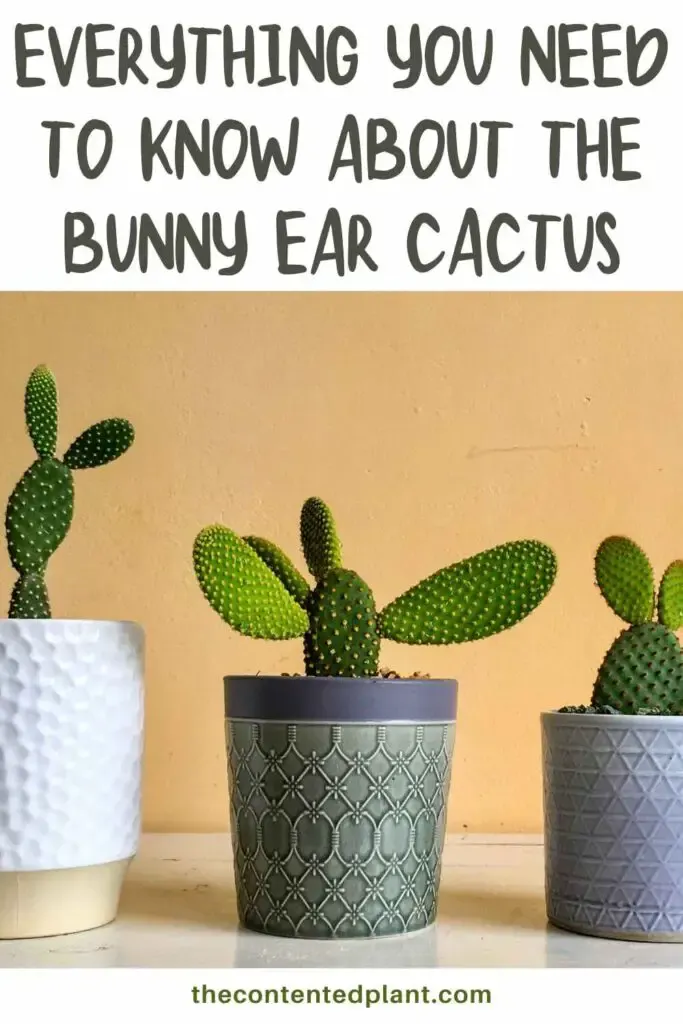The Bunny Ears cactus (Opuntia microdasys) also commonly known as the Polka Dot cactus, is a striking species of cactus belonging to the prickly pear cactus group. Native to Mexico, this prickly pear cactus has gained popularity worldwide. It’s an adorable, charming cactus. The easy Bunny Ears cactus care requirements make it a wonderful plant for the home.
What sets Opuntia microdasys apart is its distinctive growing habit of producing ears on the pad tips. And the pads are sprinkled with numerous small, soft spines known as glochids. These glochids, give the plant its adorable polka dot look.
Opuntia microdasys is VERY cute. The bunny ear-shaped pads, typically green or pale yellow in color, make it an eye-catching addition to any plant collection or garden. The presence of glochids adds a fuzzy soft looking texture creating a whimsical and playful atmosphere.
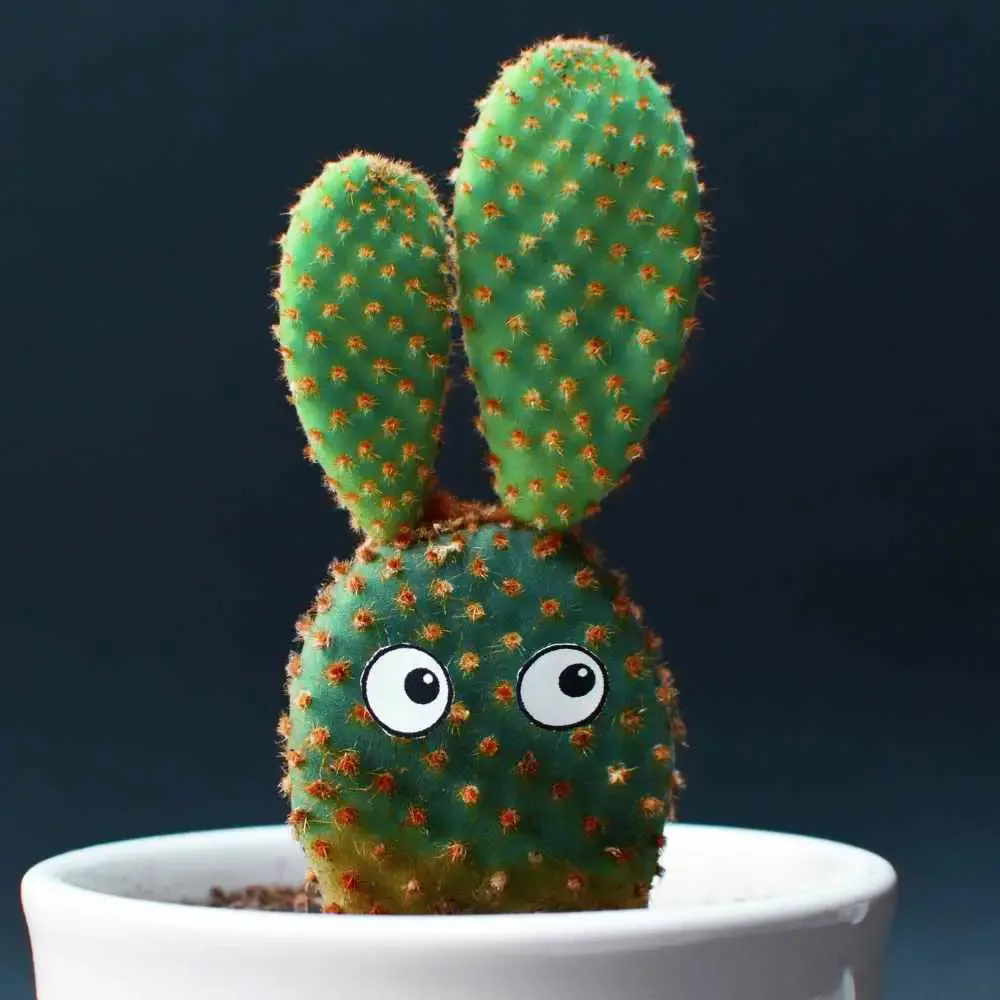
Cultivars of Opuntia Microdasys:
Bunny Ear Cactus come in a number of varieties. The exact number of cultivars may vary, and new ones may be introduced over time as breeders continue to work with the species. Here are a few popular cultivars:
- Opuntia microdasys ‘Albata’ is known for its white or pale yellow spines, creating a striking contrast against the green pads. Look for “White Bunny Ears” or “White Polka Dot” cactus.
- Opuntia microdasys ‘Aurea’: Also known as the “Golden Bunny Ears” or “Golden Polka Dot” cactus, has bright yellow pads and spines. This is a showy vibrantly colored cactus.
- Opuntia microdasys ‘Pallida’ has pale yellow or cream-colored pads and spines. It is sometimes called the “Pale Bunny Ears” or “Pale Polka Dot” cactus.
- Opuntia microdasys ‘Sunrise’ features pads that transition from green to a vibrant orange or red color. It is often referred to as the “Sunrise Bunny Ears” due to its colorful display.
- Opuntia microdasys ‘Polka Dot Gold’ has bright yellow-green pads covered in numerous small spines, creating a distinctive polka dot appearance. It is a popular choice among cactus enthusiasts.
Availability may vary depending on your location and the nurseries or suppliers in your area. Keep your eye peeled for new, fun bunny ears at the garden shops in your area.
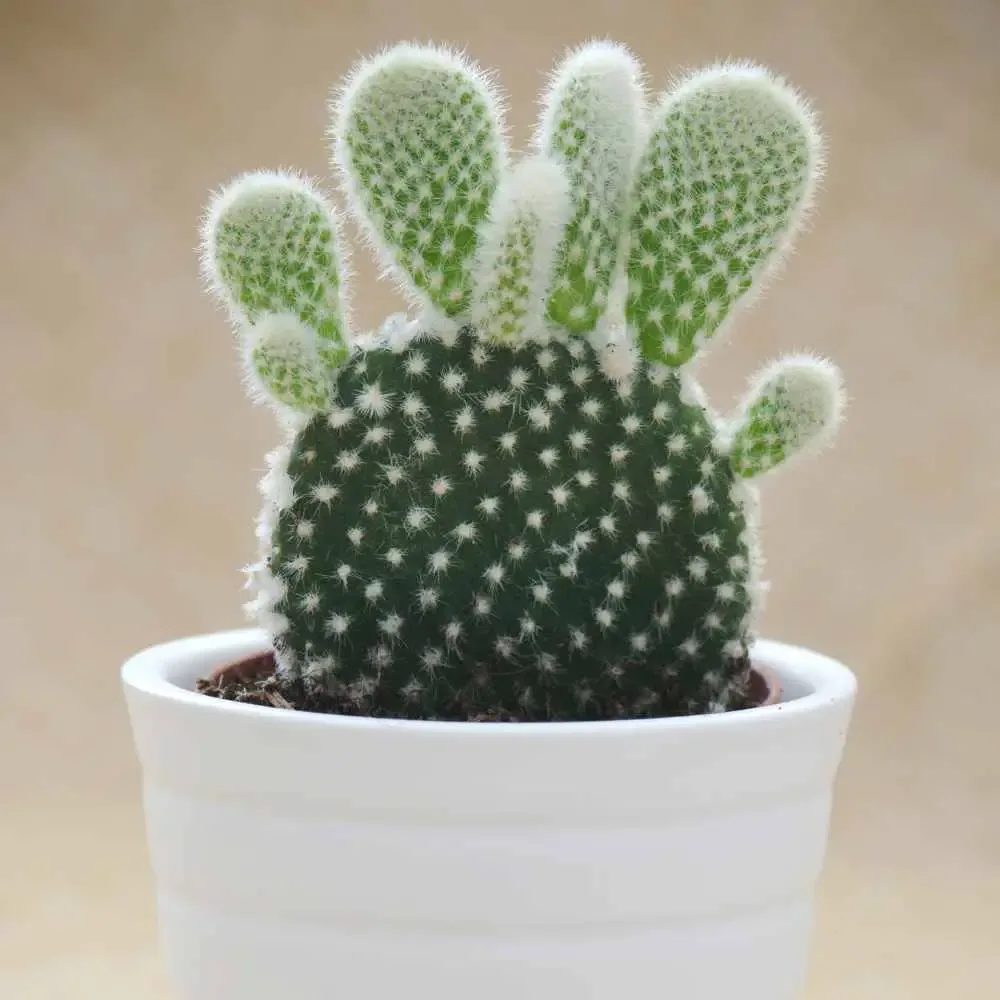
Sourcing Bunny Ear Cactus:
Local garden shops often carry various bunny ear cactus during the year. If you don’t see what you want locally, try ordering one from the shop.
Otherwise, the internet has become a great resource for finding and purchasing plants. We like purchasing plants from ETSY shops. They are often well run shops that specialize in the plant you want and they are experts at safe handling your plants during shipping. Be sure to look for a well rated shop with a good history of reviews.
Growing Bunny Ear Indoors:
The Bunny Ear cactus (Opuntia microdasys) is a small-sized prickly pear variety, making it perfect for a houseplant. With good care and proper conditions indoors, the Bunny Ear cactus (Opuntia microdasys) can reach a size of around 1 to 2 feet (30 to 60 cm) in height and width in your home. The growth rate and ultimate size will depend on lighting, temperature, humidity, and available space.
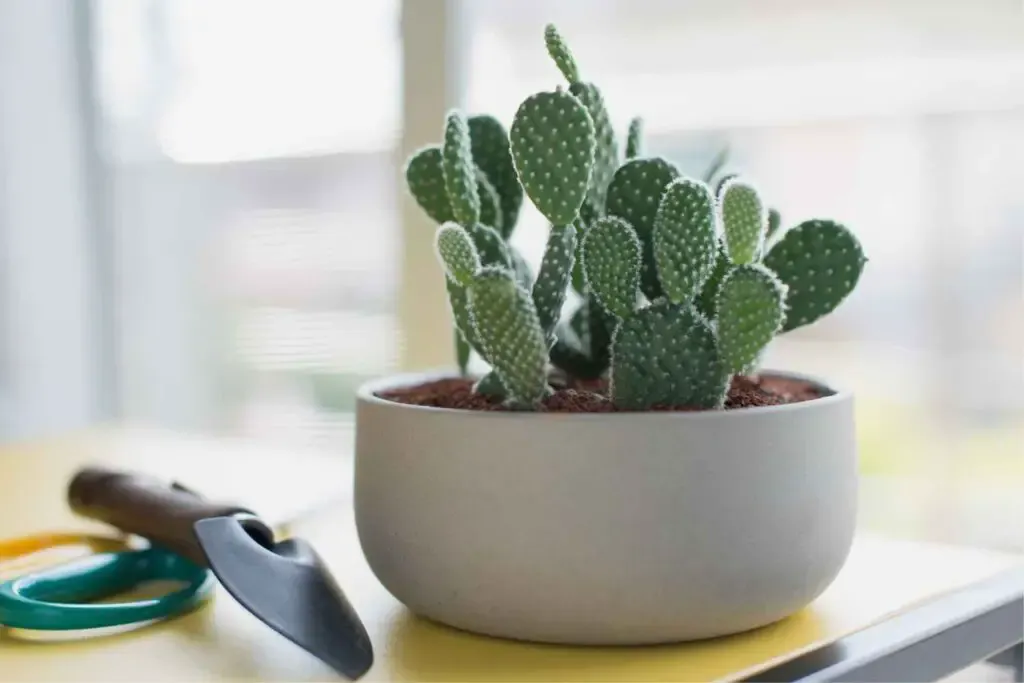
Bunny Ears Cactus Care:
All the Opuntia microdasys varieties are known for their resilience and ability to thrive in diverse environments. This cactus prefers bright, indirect light but can tolerate partial shade. It is also adaptable to various temperature ranges, but it does thrive best in warm climates.
Proper drainage is crucial for this plant. (Read our post on watering Succulents for great tips). This cactus is susceptible to root rot in longstanding, overly moist conditions. Opuntia microdasys can withstand drought conditions, but regular watering during the growing season encourages healthy new growth.
How do you take care of a bunny ear cactus? The Bunny Ear cactus care is simple. With little trouble for you, it can thrive indoors and maintain its compact size. This is a delightful addition to your indoor plant collection. Let’s dig into its care needs.
- To encourage healthy growth, provide the Bunny Ears cactus with bright indirect light or a few hours of direct sunlight each day. A south-facing window or a spot near an east or west-facing window work well.
- Ensure the plant is kept in well-draining soil, and water it sparingly, allowing the soil to dry out between waterings. Overwatering can lead to root rot, so it’s best to err on the side of underwatering.
- Regularly inspect the plant for any signs of pests or diseases and take appropriate measures if necessary.
- Pruning can also help maintain its shape and control its size if it starts to outgrow its designated space.
Remember to adjust care according to specific conditions and the needs of your Bunny Ear Cactus. Regular observation and maintenance will help ensure the plant’s health and longevity.
Here’s a Quick guide summarizing care instructions for the Bunny Ear Cactus (Opuntia microdasys):
| Care Aspect | Care Instructions For Opuntia microdasys (bunny ear cactus) |
|---|---|
| Light Exposure | Bright, indirect sunlight to partial shade |
| Temperature | Average to warm temperatures (60-85°F / 15-29°C) |
| Watering | Allow the soil to dry out completely between waterings |
| Soil | Well-draining cactus or succulent soil mix. (Read this post on best succulent soil mixes) |
| Fertilization | Use a balanced cactus fertilizer during the growing season |
| Pruning | Use gloves and tongs to remove glochids or spines (glochids are skin irritants). |
| Propagation | Pad cuttings or offsets can be used for propagation (see more on propagation below) |
| Pests and Diseases | Watch for mealybugs or spider mites and treat if necessary. (read this post for more on pests) |
| Winter Care | Reduce watering and keep the plant in a cool location. (More on winter care for plants here) |
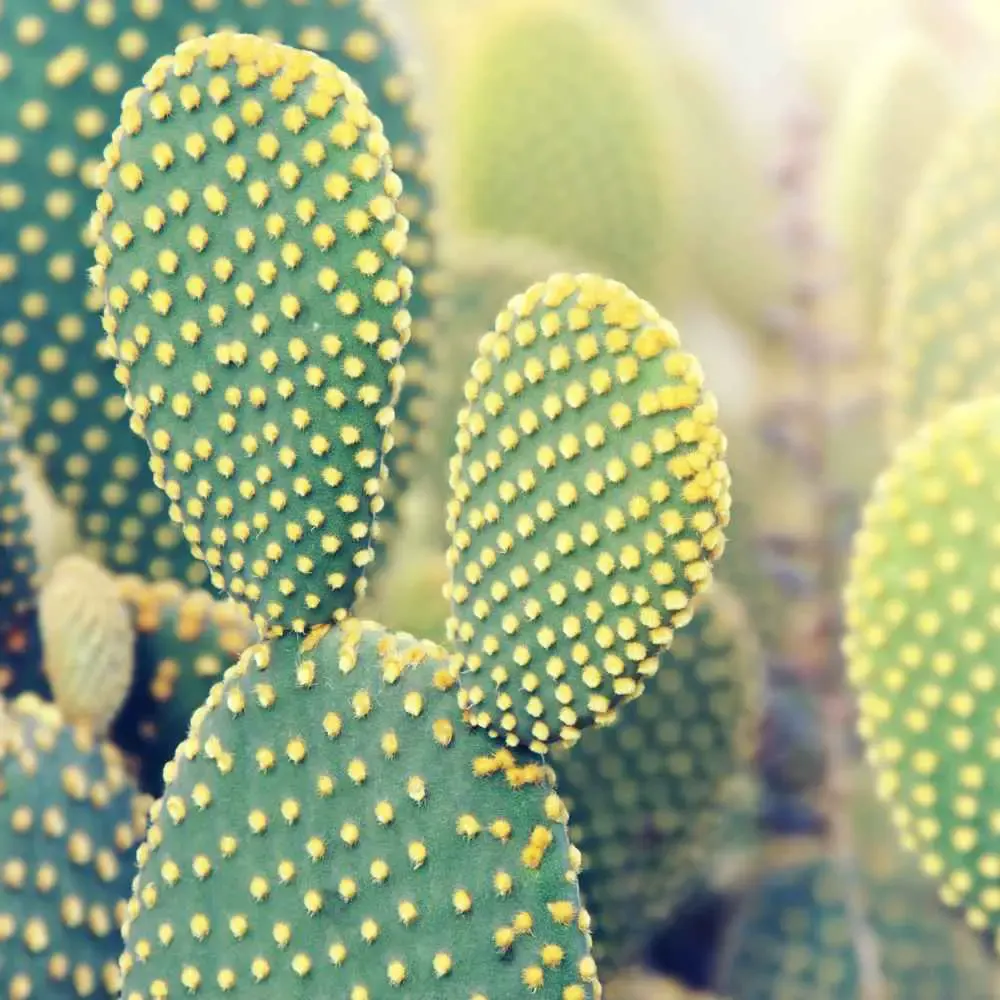
How do you Propagate Bunny Ears Cactus?
Here are three common propagation techniques for Bunny Ear cactus.
Pads or Stem Cuttings: The most common and straightforward method of propagating Opuntia microdasys is through stem cuttings or pads. Follow these steps:
- Select a healthy pad or segment from the parent plant. Choose a pad that is mature and not too young or too old.
- Allow the cut end of the pad to dry for a few days, allowing a callus to form. This helps prevent rotting when planted.
- Plant the pad or segment directly into well-draining cactus or succulent soil. Insert it partially into the soil, leaving a small portion above the surface.
- Water sparingly at first and gradually increase watering once roots have developed, usually after a few weeks. Be cautious not to overwater, as excessive moisture can lead to rot.
Seeds: Propagating Bunny Ear cactus from seeds is another option, although it requires more time and patience. Here’s what you can do:
- Collect ripe fruits from the parent plant when they are fully mature and beginning to dry out.
- Extract the seeds from the fruit and clean them.
- Prepare a well-draining soil mix suitable for cacti and fill small pots or trays with the soil.
- Sow the seeds on the surface of the soil and lightly press them down. Do not cover them with soil, as they require light to germinate.
- Place the pots or trays in a warm and bright location, ideally with indirect sunlight.
- Keep the soil slightly moist but not overly wet. It’s important to avoid overwatering, as excess moisture can lead to seed rot.
- With patience, the seeds will germinate, and once the seedlings are large enough, they can be transplanted into individual pots.
Offsets: Opuntia microdasys may produce offsets or “pups” around the base of the parent plant. These can be separated and propagated as individual plants. If your plant does grow a pup this is by far the easiest and fastest way to start new bunny ears. Just Follow these steps:
- Carefully remove the offsets from the parent plant, ensuring you include some root tissue.
- Allow the cut ends to dry and callus for a few days.
- Plant the offsets in well-draining soil, burying the roots slightly while keeping the top portion above the soil surface.
- Water sparingly initially and gradually increase watering as the new plant establishes roots.
Regardless of the propagation method you choose, it’s important to provide the new plants with appropriate light, water, and soil conditions suitable for cacti. Patience is key, as it can take some time for the propagated plants to establish and grow.
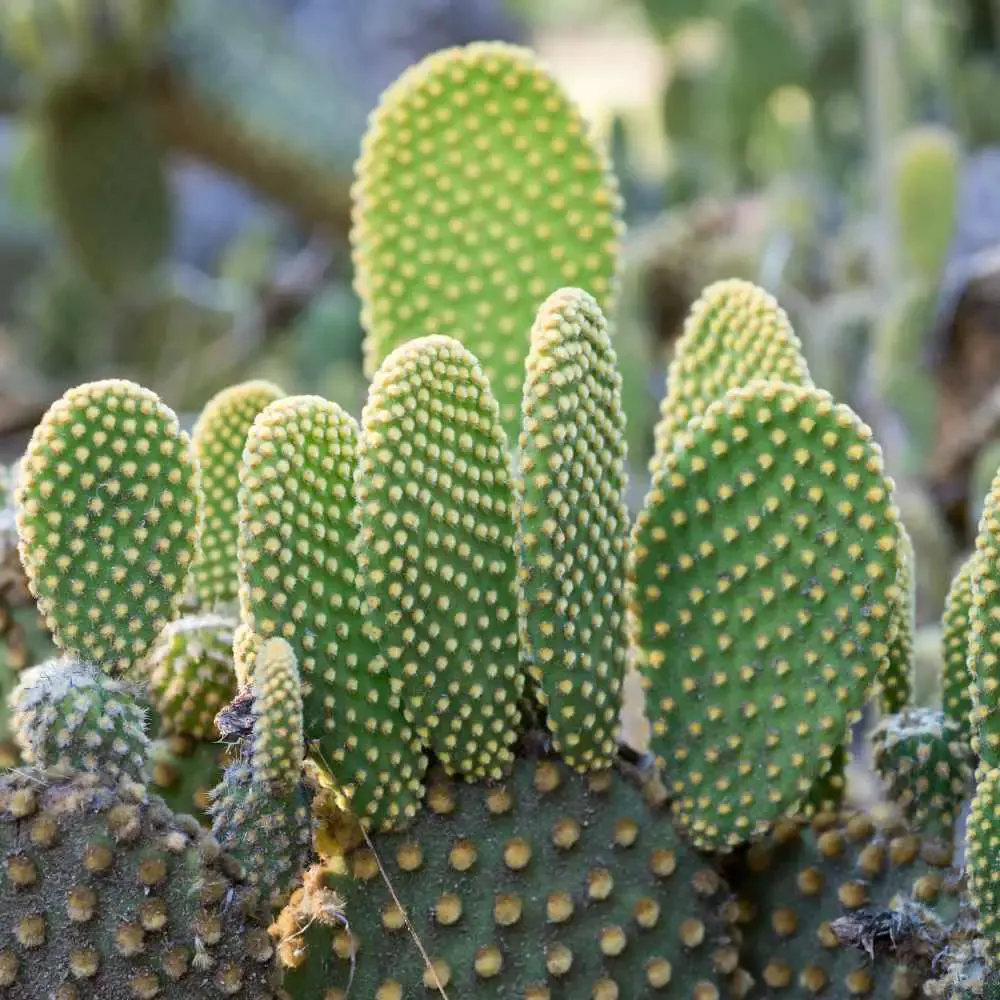
Growth Habit of Bunny Ears Cactus:
Do bunny ear cactus always look like a bunny? No. The number of pads or “ears” on a Bunny Ear cactus can vary depending on the age, growth, and overall health of the plant. While some Bunny Ears cactus may initially start with two pads, as the cactus matures and continues to grow, it will normally grow additional pads over time. But if you really love the bunny shape you can attempt to maintain it as the cactus grows through pruning off the extra ears and keeping your bunny small.
Opuntia microdasys (like many of the prickly pear cactus-More on prickly pear cactus here) has a clumping growth habit. New pads can emerge from the base of the plant or from existing pads. As the cactus grows, it has the potential to produce multiple pads. This gives microdasys a more complex, interesting structure. These new pads can sprout either adjacent to the existing ones or in different locations along the stem.
The specific growth pattern and number of pads often varies between individual Bunny Ear cacti, and within different cultivars of Opuntia microdasys.
Plants are very beneficial to people emotionally and as an environmental addition to your home.
Read more about why houseplants are beneficial to people here .
The Contented Plant
How often Do Bunny Ear Cactus Bloom?
Bunny Ear Cactus produces vibrant flowers, often in the spring or summer, which further enhance its charm. These flowers give way to small, edible fruits that resemble tiny, red or yellow berries, adding another intriguing aspect to this delightful cactus species.
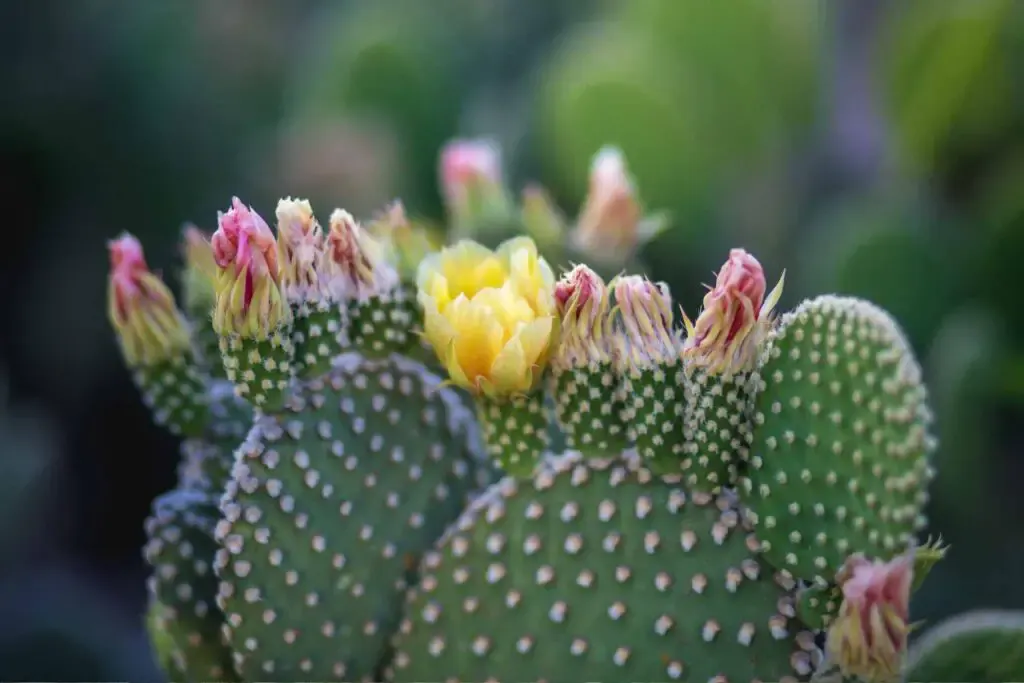
Growing Bunny Ear Cactus in Outdoor Gardens:
Bunny Ears (Opuntia microdasys) can do well in outdoor gardens, particularly in regions with a warm and dry climate. This cactus species is native to Mexico, where it thrives in arid and desert-like conditions. If you live in an area with similar climate characteristics, Bunny Ears can be an excellent addition to your outdoor garden. Garden zones 9 to 11 are good choices for growing this cactus outdoors.
When planting Bunny Ears in an outdoor garden, ensure that the soil has good drainage to prevent waterlogging. Heavy soil containing excessive moisture can lead to root rot. Sandy or rocky soils are often suitable for Opuntia microdasys.
And keep it sunny. Plenty of direct or indirect sunlight is a must for this cactus to do well outdoors. This cactus enjoys bright light and will benefit from several hours of sunlight each day.
One advantage of growing Bunny Ears in an outdoor garden is the potential for larger and more vigorous growth compared to indoor cultivation. In favorable conditions, Opuntia microdasys can develop into a sprawling plant, forming beautiful clumps or even hedges. However, be mindful of its spreading nature and provide enough space for the cactus to expand without overcrowding other plants.
Keep in mind that Bunny Ears can be sensitive to cold temperatures and frost. If you live in an area with colder winters, it is advisable to provide protection or move the plant indoors during freezing conditions. Overall, with proper care and attention to its specific requirements, Bunny Ears can thrive and make a stunning addition to your outdoor garden.
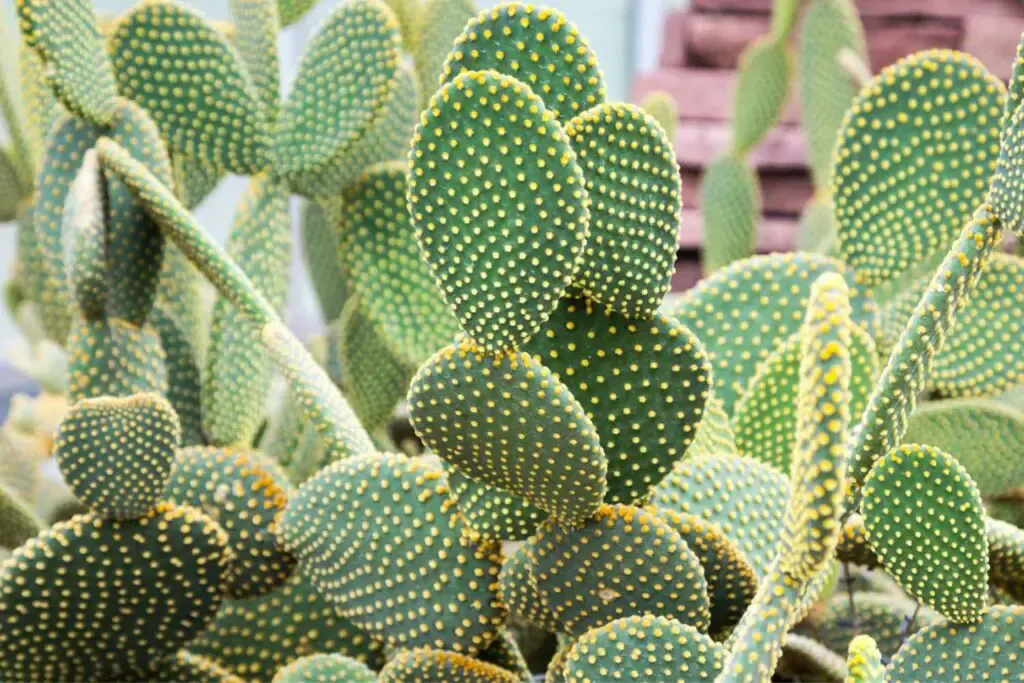
Invasive Plant Alert:
While Bunny Ears cactus is not typically classified as invasive, exercise caution when cultivating it outdoors. Opuntia species, in general, have the potential to spread and establish themselves in certain environments under specific conditions. If the cactus is not properly managed or if it escapes cultivation, it may over populate in some regions.
Where Opuntia species are not native, they can sometimes become problematic if they outcompete native plant species or invade sensitive habitats.
To prevent unintended spread and potential invasive behavior, grow Bunny Ears cactus in containers or well-maintained garden beds. Regular monitoring, pruning, and careful disposal of any plant fragments can help control the spread of this cactus and minimize its impact on the surrounding environment.
Non Toxic Plant:
Bunny Ears is not toxic to pets or humans if eaten. However, the prickles (glochids) will easily come off the plant and embed themselves in skin. They are irritating and difficult to remove. Use tape and then tweezers if necessary.
Related Content:
Follow Us:
Find us on YouTube, Instagram , Pinterest and TikTok! We love to Plant chat. We also comment, like and occasionally share your content to our daily stories. We’d love to see your plants. Share your joy in your houseplants. Happy Planting!
